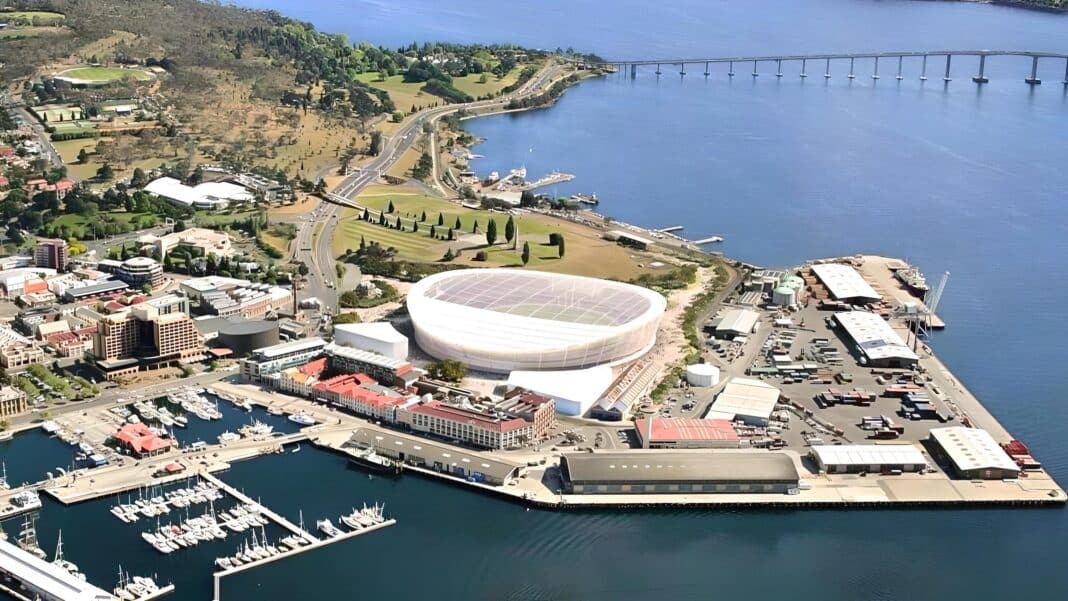It is on brand. It will drive investment in timber manufacturing, embed carbon, and capture the public’s imagination … but could Brisbane’s new Olympic Stadium and Tasmania’s AFL stadium be built using timber?
That was the question ABC Radio Hobart Mornings host Leon Compton posed to University of Tasmania’s School of Architecture and Design Professor Greg Nolan last year – an expert in timber design and construction.
According to Professor Nolan, the answer is ‘yes’, but with caveats.
“You can build a timber-rich stadium, which means you use timber where it is best suited.”
Multi-storey structures have ground floors laid in concrete and steel, with timber on the upper floors.
“What has evolved over time is for the lower floors to have concrete structures, and then from that, you spring up wood from above.”
This timber has a spanning capacity that is economically suited. Same with concrete. So you build the first floors to suit the car parking and make a platform to go up with timber from that point.
Can timber work with curved and slopped services?
Both stadiums, which need to be oval in dimension, present unique challenges for construction.
“You can get a whole range of timber products. You’ve got glue-laminated timber and cross-laminated timber, and you can form a plate or a slab,” Professor Nolan noted.
“Not too dissimilar to a tilt slab or precast concrete panel, timber can be manufactured in a factory, and because it’s timber, it can be routed within a millimetre of accuracy and can assemble on-site like a large panel set.”
Nolan noted that these products all use steel fixings and concrete fittings.
Can a timber-rich stadium be designed for maximum durability?
According to Nolan, keeping timbers out of the weather is the key. Under a roof, timber materials will last hundreds of years.
“The material you put outside must be satisfactory for use outside and can be easily replaced.”
Nolan noted that you can take two approaches – inside, you can use almost all species, but outside, you will need to design it so that it can be replaced every 15, 20, or 30 years.
“That’s part of the sustainable design approach.”

Satisfying regulations
In Australia, building regulations constrain the use of flammable materials on an external envelope.
“That may mean we have some regulatory constraints on cladding a building of this size, an equivalent of an 8-or-9 8-or-9-storey building.”
So, the fire ratings of the envelope may constrain timber from being used externally – unless combined with external glazing.
Is Tasmania capable of delivering a timber-rich stadium?
So, what sort of investment needs to take place?
“We can build it in Australia,” he said, referring to the proposed $715 million Macquarie Point stadium, which is in the news in the lead-up to the 2024 Tasmanian State Election.
“The timber may come from Tasmania, go to Melbourne for manufacturing and fabricated and brought back into Tasmania.”
“There are companies that can use high-quality routers and milling machines to satisfy large-scale projects. But whether that happens remains to be seen.”
CUSP, he said, is an example of a Tasmanian cross-laminated timber company that is now quoting on stadium and basketball stadiums across the state.
What is the cost-benefit of building out of timber products?
According to Nolan, there is precedent in Australia for a project of size.
“In Sydney, there is a 100 m timber roof over the Sydney Exhibition Building. It’s a combination of glulam and steel which is larger than Macquarie Point.”
“It was built in 1998, and most of the timber was Tasmanian glulam.

The Exhibition Hall was designed and constructed using glulam, specified by the architects, Anchor, Mortlock, and Wooley for its unique aesthetics, cost-effectiveness, and environmental credentials. After 25 years the dome remains one of the largest clear-span timber structures in Australia.
Low carbon budgets
Buildings, developers, and architects are now looking for low-carbon building materials.
Ahead of the Brisbane 2032 Olympics – which will be the first carbon-neutral games – developers are now looking to low-carbon budgeting into future precinct development.
It’s now up to the professionals to look at ways to reduce carbon in buildings.
“Timber is the only major building material we’ve got that has carbon sequestration, and therefore, if you want to reduce your carbon budget, you need to use timber in your carbon budget,” Nolan emphasised.
“Unless we make our buildings out of low-carbon materials, we will not meet low-carbon targets.
“You can take two different approaches. Inside, you can use almost all species if kept dry, but outside, it is much more exposed to the elements, and you accept that you will replace it every 15, 20 or 30 years to remain in good working order.”
- To read about the $2.7 billion Brisbane 2032 Olympic Stadium and Hobart’s $715 million Macquarie Point Stadium, read Wood Central’s special features.






